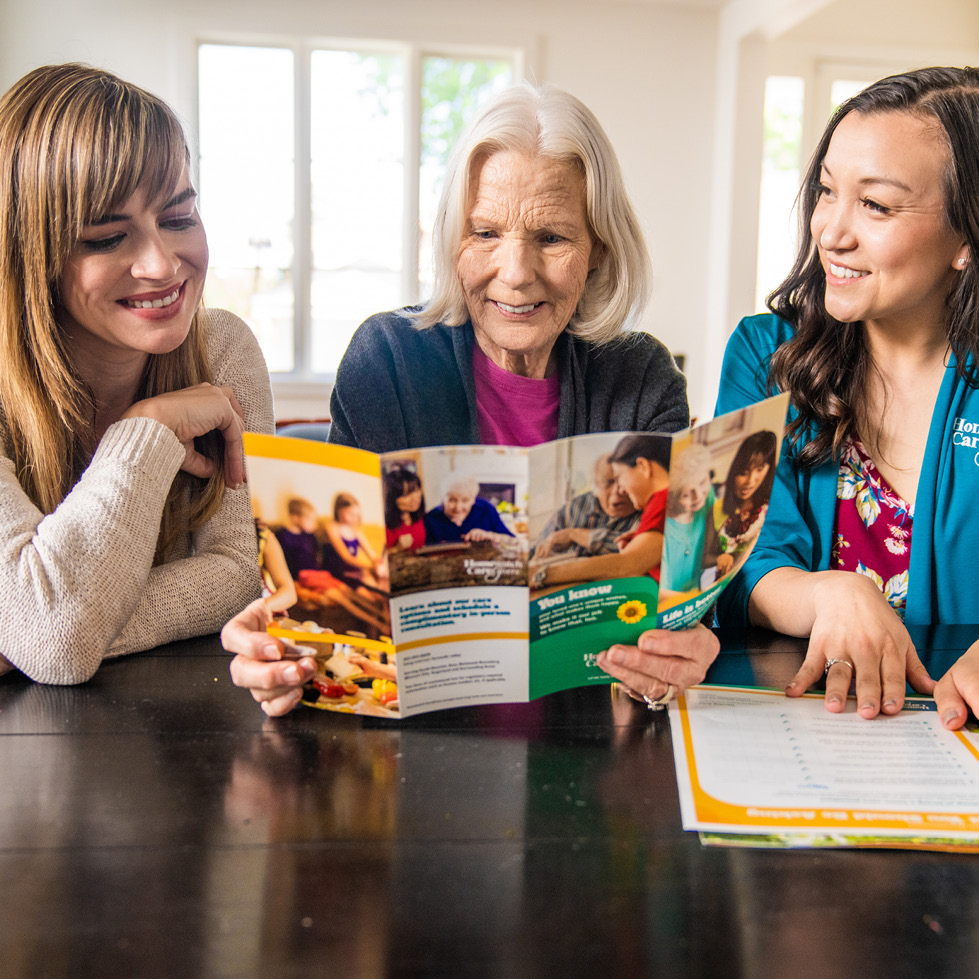There are many types of doctors, healthcare professionals, and medical aides. Similarly, various types of caregivers may be involved in assisting your loved one with their activities of daily living.
Let’s explore the different kinds of caregivers. They may either serve as individual caregivers or as part of a caregiving team.
The 6 Types of Caregivers
1. Family caregivers
Statistics tell us that the most common type of caregiver for the elderly is a middle-aged daughter caring for an elderly parent or parent-in-law. But of course, that does not tell the whole story. A spouse may also become a caregiver. A college-age grandchild may even become a caregiver. Same for a dear friend or neighbor, and so on.
There might be several family members pitching in to help, or a whole family may essentially become caregivers if a loved one moves in when help is needed.
Can a family member get paid to be a caregiver?
While family caregiving is usually an unpaid role, in some states there is Medicaid reimbursement available for family caregivers.
For family caregivers with a loved one who holds a long-term care insurance policy, you can be paid to care for your loved one by joining the Homewatch CareGivers team. This way, your loved one will be cared for by your family, but the family member performing the care will be paid for their time. The family caregiver will also receive valuable training from us. To learn more, schedule an interview online.
2. Nonmedical in-home caregivers
A professionally-trained caregiver helps clients in their homes with daily tasks to protect their physical safety and general well-being.
What do nonmedical caregivers do?
Nonmedical in-home caregivers might help someone safely get in and out of the shower, provide medication reminders, safely assist with lifting someone from a bed or chair, or perform meal preparation. These caregivers can also become companions who are there to listen, enjoy a game or activity together, talk about the day’s news, and in other ways be a friend while also providing the care needed. These caregivers can simultaneously provide respite care for family caregivers who need a break to take care of themselves.
3. Home health care caregivers
Home health is not the same thing as home care and is usually medical and prescribed by a physician for a short-term medical need. Many health insurance plans cover home health care services, unlike general home care.
What does home health care provide?
Specialized, short-term home health care services may include, but are not limited to:
- Checking vital signs such as blood pressure, heart rate, and temperature.
- Wound care.
- Pain monitoring and management.
- Injections and IV therapy.
- Medication management assistance.
- Dietary consultation.
- Patient and family member education.
- Care coordination with other medical providers, such as a primary physician.
4. Hospice caregivers
Hospice caregivers supplement the care of daily activities for clients who are near the end of life. Hospice care specifics will vary depending on the organization and perhaps even state regulations.
Is hospice end-of-life care?
Yes, hospice is a type of end-of-life care. Home hospice care is available to those with a fatal condition who are no longer receiving life-saving treatment and whose life expectancy is six months or less. Hospice care emphasizes patient comfort and provides space for the patient and their friends and family to spend quality time together.
5. Virtual caregiver
When it’s not safe for people to receive caregivers into their living space, such as patients with highly contagious illnesses, virtual care is a good option. A professional caregiver taking the necessary safety precautions can assist with technology so an individual can connect with a medical provider or a family member who cannot be there in person.
What is a virtual caregiver?
A virtual caregiver performs limited caregiver duties from a remote location. These duties can include mental health checks, following up on pain levels, and calling the client to remind them to take their medications. Some virtual care programs offer monitoring and alert devices to provide additional around-the-clock safety measures. Virtual visits can also provide the individual with someone to talk with about their concerns or joys of the day.
6. Adult day services
Not everyone thrives in their home environment, and there can be some benefits to spending time at a local adult day services center. These organizations provide activities and social opportunities for people over age 65. Some adult day centers also offer physical exercise options. A family or nonmedical in-home caregiver might be of help with personal hygiene and transportation before and after these outings.
What Are the Benefits of Adult Day Care?
The benefits of adult day care include but are not limited to:
- Socialization.
- Mental stimulation through enrichment activities.
- Opportunities to learn from others.
- Physical activity.
- Nutritious meals, depending on the program.
- Staying active and engaged.
- A respite period for family caregivers.
Other Types of Caregiving
While nonmedical caregivers can do some light housekeeping, a professional house cleaning service can provide a valuable service by keeping a home pleasant and safe for those who are not up to these routine chores.
Meals on Wheels is a nationwide volunteer organization that provides seniors with hot meals and can be paired with other types of caregiving.
How Your Local Homewatch CareGivers Can Help
When it’s time to find a reliable and trustworthy nonmedical home care provider, your local Homewatch CareGivers will be there.
Each caregiver is thoroughly background-checked and must pass a DMV check as well. They receive ongoing training to improve their skill set and stay up-to-date on the latest home care techniques. Plus, each client is carefully paired with a caregiver who share similar interests and backgrounds.
Ready to learn more? Simply complete our online form, and schedule your complimentary consultation.




